Barry Lederer
Interview
| Name: | Barry Lederer |
| Type: | Disco-DJ, Billboard Reporter, Fashion Show Producer |
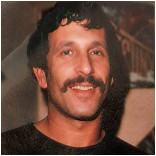
Disco Mix By BARRY LEDERER
In March/April 2004, I e-mailed Barry Lederer and spoke to him about his career in the music business. Throughout our talk, he shared with me interesting facts about the early days of disco and his beginnings as a DJ at several New York and Fire Island clubs. He also told me about his experience writing the “Disco Mix” column for Billboard magazine; his company, Graebar Productions, which designed and installed sound systems for some of the most famous clubs in the U.S.; and his long-time successful period creating and arranging the music production for fashion shows around the globe.
Beginnings:
hotdiscomix: Where were you born, where did you grow up?
Barry Lederer: I am a true-bred New York City resident, born not too long ago in Far Rockaway, Queens. I grew up in the Bronx and then moved to Long Island. I graduated from Alfred University (NY) and then proceeded to do social work in New York City. All through high school and college I was always listening to music.
hotdiscomix: After graduating from college, you worked as social worker in New York. Describe your work at that time.
Barry Lederer: I worked as a social worker for the city and state of New York. While working for the city, I was a regular caseworker, handling cases of individuals or families on welfare and checking on their status and making sure that all was ok. The workload was incredible. From there I went on to work for the state, again as a social worker. There I inspected old-age homes, drug rehab centers and the like for which the State of New York was responsible. I had to make sure that they kept their facilities up to code.
hotdiscomix: When did you discover your interest in music and what was your first step into the music business?
Barry Lederer: My interest in music started in high school. I was an avid record collector even then. When I attended college, as stated above, I continued this interest. In college, I was social chairman of my fraternity and actually taped songs from the radio for our frat parties. When I moved to New York City after college, I threw parties in my apartment usually from lousy tapes I made.
My first break came when I stopped by a club called The Firehouse, in SoHo, not too far from where The Loft was located. The Firehouse had dances on Fridays and Saturdays. I wasn't having much luck with the pop sounds the resident DJ was playing.
Having been to Fire Island, where the music was way ahead of New York City, I complained to the management. They said “Can you do better?”. Well, three weeks later I did do better, and was playing live in front of 300 people. Though the mixes left much to be desired, within a month, word had spread and a crowd of over 1,500 was showing up weekly.
This was the beginning.
hotdiscomix: Do you recall the records you were playing at the time?
Barry Lederer: Yes. Some commercial stuff like “Brown Sugar” by the Rolling Stones, and “Nathan Jones” by the Supremes, but also “Harlem” by Bill Withers, “Life And Death In G & A” by Abaco Dream, or “Feel The Need In Me” by the Detroit Emeralds. Let’s not forget “Black Skinned Blue Eyed Boys” by the Equals, or “Rain” by Dorothy Morrison.
hotdiscomix: Please tell me a bit about your story as a DJ and the clubs at which you performed.
Barry Lederer: I started out at The Firehouse, as you already know. After that, The Botel, a popular club on Fire Island, offered me a gig from ’72 to ‘76. The Botel was renowned for its “Tea Dance” parties, that offered dancing on Saturday and Sunday afternoons from 4 to 7 p.m. From there, I went down the block to the Sandpiper (now the Pavilion), where I performed for 3 years. Both The Botel and the Sandpiper were considered the best places to play at. Why? Because all the best DJs and promo people came out to the Island. Obviously this portion of the Island was gay, as were almost all top DJs, promo people and so on. The gay clubs in New York City and others around the country were the first to try out new music.
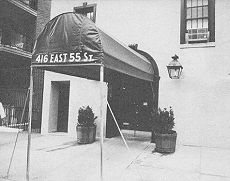
Entrance "Le Club"
Also during my time I played at numerous straight and exclusive clubs like Le Club, Hippopotamus and Doubles. These were all for the very rich and enabled me to see things from another perspective. I was at these clubs from the mid seventies and on. In Le Club I played for three years. Prior to me was a thin black gentleman named Slim Hyatt, who is actually considered to be the real first DJ. I also met him when I played at Doubles, which was located in a very exclusive hotel at 5th Avenue and 60th Street. I was there for about 2 years or so. Le Club was the predecessor of Studio 54 only in that it catered to the rich and famous (like a Frank Sinatra). It was in a gorgeous town house where you had dinner and then danced. Although what I had to play was mostly real commercial, I believe a good DJ should learn to play all types of music.
You know about The Botel and the Sandpiper at the Fire Island Pines. These were, I would say, the main clubs. The audience was the best in New York and everyone went there. This happened at a time when I was a Billboard reporter and then Disco Mix columnist. As a deejay, I worked along with Tom Moulton, who shared with me a lot of his acetates of songs yet to be released. That is why these two places were important.
From about 1980 and on, my fashion show business took off, so I stopped playing, though I was and still am a member of the For The Record Pool, I guess because of my help from day one.
hotdiscomix: What is the favorite club at which you worked and what is your most memorable event experience?
Barry Lederer: No doubt — the Sandpiper. It was here that I was most challenged as the crowd was so particular and critical, just like any gay clubs, but more so here.
However, once again, I was lucky to have access to the right records as well as advances from all promo people and a great crowd who loved to dance.
The most exciting events or times I have had were when I played a tune and saw the crowd go wild. The Saturday nights were always the best, for everyone was ready and roaring to go. Personally, my best time was the new years eve party at 12 West when Jimmy Stuard was playing. He had made a special ½ hour tape to finish exactly at 12 midnight. The mixes were the best I had ever heard and the crowd went wild when, at 12, over the noise you heard The Trammps doing disco “That’s Where The Happy People Go”. A great moment never equaled.
hotdiscomix: Every DJ worth his salt could cite a record that they were credited with spinning before everyone else (e.g., “Theme From Shaft” went to Bobby DJ Guttadaro, or “Girl You Need A Change Of Mind” to David Mancuso). Is there a record which you spun before everyone else?
Barry Lederer: I had thought I was the first to play “Love’s Theme” by Love Unlimited Orchestra from an acetate, but was told that Bobby DJ had it first. I did get a gold record for playing “Do It (‘Til You’re Satisfied)” by B.T. Express.
Also, working with Tom Moulton, many of his mixes I would try out in the Tea Dance at The Botel, and he would play at night at the Sandpiper.
hotdiscomix: Are there any deejays in the industry whom you hold in high esteem? Who and why? What quality or style do they possess that you admire?
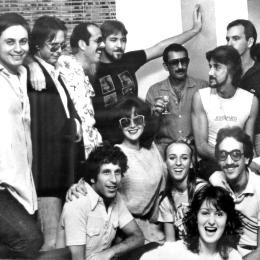
Barry Lederer about 1976 (bottom left)
Barry Lederer: Sure, Don Finley who played at the Sandpiper in 1971 just prior to Tom Moulton – he was absolutely flawless. Francis Grasso at the Sanctuary, Jimmy Stuard at 12 West, as well as Tom Savarese who was way before his time. Their quality was in how well they played and went from one song to another, but more often there selection and how they put it together. They had a plan for the evening and could change at any moment. They could bring you up and down with the music and take you on a trip. They only had their records to play, not all the tricks of the trade like today’s DJs. Summing it up, they played great records and knew when to play them.
hotdiscomix: The Firehouse was the headquarters and community central of one of the first post-Stonewall gay political activist organizations in New York, the “Gay Activists Alliance” [GAA]. Were you also a GAA member?
Barry Lederer: I must say that in all my years, I was never an activist. I was just a lucky soul who stumbled upon The Firehouse with friends, became a regular, and eventually a DJ. Though not the greatest as I have said before, but I knew how to please the audience, so I played great music and left them cheering for more.
Graebar Productions:
hotdiscomix: As the Graebar Sound team, did you and your partner, Peter Spar, ever design sound systems for some famous clubs in the U.S. When did you start designing these sound systems?
Barry Lederer: In the early seventies. We did 12 West, The Anvil, and Les Mouches in New York, The Botel in Fire Island, Probe in Los Angeles, Trocadero Transfer in San Francisco, Salvation in Miami, another club I cannot remember in Toronto. The last and best system we installed was for the famous Saint, in New York.
Trocadero’s Graebar sound system was perfectly matched to its warehouse space, and there just wasn’t a bad spot on the entire dance floor to hear Bobby Viteritti’s magic over that brilliant system. Even though The Saint, Probe, 12 West and other clubs had the same Graebar components, no other DJ knew how to keep the system in balance like Viteritti. He was famous for working the Audionics Space and Image Composer (which provided the quadraphonic simulation in the Graebar system and was mounted above the Bozak mixer in the booth) to throw single notes around the room and do a dramatic sweep of a tweaked sound effect that would get us all spinning. He would also couple that sweep effect with a feedback loop he would create using an open-reel tape deck, which put an incredible echo and delay on whatever was playing. Talk about fucking with our heads! Other DJs just weren’t doing stuff like that in 1979; phasing two records was the extent of most “special effects,” but Bobby always took it a step further. When Viteritti would come down to L.A. to play at Probe, he would always tune the Graebar system for his night and then reset the controls back to where he found them before leaving—and boy was there a difference! He had magic ears and could close his eyes, listen, and make that Graebar sing like Barry and Peter intended it to.
The Garage is commonly credited with having the best club sound system ever—and I’ll admit that it was pretty special—but Peter and Barry consistently installed awesome systems and knew how to make any room sound wonderful.
The Garage had those custom bass speakers and Richard Long’s electronic crossover (which I also had at Private Eyes), providing the bass power and an intense bottom, but I’ve always felt that Graebar was a more balanced, warmer, and listenable sound that was better suited to the mostly up-tempo, mid-range records that were played at Trocadero, The Saint and 12 West.
hotdiscomix: Barry, please tell me some technical facts about your sound systems, especially the ones at 12 West, Probe, Trocadero Transfer and The Saint.
Barry Lederer: Peter Spar was actually the technical expert of my company so my knowledge is limited. All clubs has hanging or cornered ‘Coffins’ like boxes. Bass cabinets were always part of the bottom rows of seats. We also used tweeter arrays placed over the dance floor. Also utilized Phase Linear power amplifiers and RG Sound expander, which raised the volume of the music with a rich and lush sound.
hotdiscomix: What was the difference between Graebar systems and the systems from Alex Rosner or Bob Casey?
Barry Lederer: I think it was just a sweeter and fuller, richer sound. Rosner, Casey and, of course, Richard Long were there, too, and were fine. Long has a big sound, like that of the Paradise Garage.
Billboard Magazine:
hotdiscomix: You have mentioned your work for Billboard. When and how did Billboard’s disco section start?
Barry Lederer: Both myself, Tom Moulton, and Mel Cheren introduced Bill Wardlow, then editor of Billboard, to put a disco section in the magazine. After visiting the clubs in New York and at the Island, he was more than impressed with the influence and excitement of disco. Some weeks later, Tom Moulton started a Disco Mix column, that I took over after several years.
Following is the first Disco Mix column by Tom Moulton:
Club Dialogue (New York City)
Gloria Gaynor's “Never Can Say Goodbye” is still the top record in the discos and has been for five weeks.
“You Little Trustmaker” by The Tymes
This is the original version; stronger lead singer, female back-up group, hotter mix. DJ's have been trying to obtain this version but it is not available commercially, although some disco DJ's have obtained copies of this version which has jumped into their top 10 within the past for weeks.Free Spirit's “Just As Long As I Can”
(Disco mix; longer and faster is available from Chess/Janus only as a special promotional copy because the disco version was released after the shorter commerical copies were released. Chess/Janus feels the commercial copies should be sold before the Disco version is released commercially.Roulette Records has mad a test pressing of the Disco-mix of “Your Love” by The Moment Of Truth (slower, original tempo and much longer than the commercial one released several months ago, which was not played in the discos). The DJ's who have it love it and play it; hopefully it will become commercially available soon.
hotdiscomix: In what period of time did you write for the Billboard magazine, especially the “Disco Mix” column?
Barry Lederer: From 1976-1982 — 6 years that were a great time to write as disco was at its peak, and during which I met so many people, both artists and DJs. Though there was always someone who wanted to be treated special, I never gave in. I felt that once it gets around that you take favors, your respect is lost. I mostly tried to expose the audience to new music that was great for the dance floor and keep my column up-tempo and positive. However, if a group that was known failed, I felt it necessary to mention it, as it was news also.
hotdiscomix: Again for the readers who may not know Billboard magazine, what was the content of the weekly Billboard “Disco Mix” column and of your reports.
Barry Lederer: Billboard magazine was a trade magazine for the music industry. It has various sections, including charts for Disco, Country, R & B, Rock and of course Pop. It enabled artists to see if their song made it to number one. It also contained a radio section which was similar in that it reported what was being played on the radio in different areas of the country. The other content included articles about individuals in the music industry as well as news on various artists. It again included information on concerts and gave figures on how well the groups did.
The format of the disco column included: first, a review of new disco releases; second, a compilation of the sales charts from important record shops. The column also had club play charts, at first from New York DJs and, with time, from DJs all around the U.S.A.
As Tom Moulton can attest, this column was read by all in the music business. The DJs looked to them to discover what was hot. The column, just like a New York Times theatre review, could make or break it for an artist. I must say that both Tom and I never abused this privilege, though it was set before us so many times. Once you give into temptation, you are listed. I did what I had to do, sometimes giving the smaller label a little more of a review. My point of view was that if it was a record I would play, I would give it a heads up. If it was from an established group and didn’t live up to expectations, I would say so.
Two other publications at this time were Cashbox and Record World, that eventually ceased publication due to Billboard’s success. The magazine kept up with the times and included charts in Hip Hop, videos and video games. It is considered a standard in the industry and has its own award show each year with honors going to groups that were on the charts the longest.
hotdiscomix: Were you involved in the drawing up of the weekly Billboard Disco Charts?
Barry Lederer: No. That was done by my boss. However, he did offer some interesting insight into the Disco charts. There was a specific number of Billboard reporters across the country. It was an honor to be one of these, and I was lucky to have this recognition when I played at Fire Island. Each DJ was given a number from one to ten according to how influential his club was. When each DJ turned in his Top 10 or Top 25, each song was then rated by Billboard. If you were a ten, then your songs were given that number. As for sales, it was initially based on several major outlets in New York City. It eventually expanded across the country. Now sales are based on SoundScan.
Disco Music:
hotdiscomix: You know the 70s club culture well. Was there a difference between the clubs on the east coast and those on the west coast?
Barry Lederer: Not really. Having done the sound for two or three of the most famous — 12 West and The Saint in New York, Trocadero in San Francisco, and Probe in Los Angeles, I can say that it was somewhat the same. I went to other places beside the ones that I did, and found that the lights, music and decor were not that much different no matter where you went and even in other cities like Chicago or Dallas or Miami.
hotdiscomix: You were the mentor for Jimmy Stuard. What was your part in his career and what other DJs did you help to find the right clubs?
Barry Lederer: When I went to Boston with a friend, we stopped by several clubs. I met Danae Jacovidis and Jimmy Stuard. I was so taken away by Jimmy’s music that I convinced the owners of 12 West to give him a try. His time there, though short, was memorable to say the least.
Also when I was in Ft. Lauderdale, I met Bobby Viteritti and suggested him as a DJ for Trocadero Transfer. In this case, too, he made his mark and became one of the country’s best DJs. Also there was Richie Rivera, who you might not know. But when I left The Firehouse and then the Sandpiper (at the Pines) I was able to name my successor. I chose him and he did very well no matter where he played.
hotdiscomix: You were involved in the startup of the first record pool. What was the name of that record pool and who were its founders? What part did you play in its establishment and development?
Barry Lederer: The name of the pool was, first, the New York Record Pool and, later, For the Record. David Mancuso, Steve D’Acquisto, Judy Weinstein, and Eddie Rivera were some of its originators. My part was getting as many of the top DJs in the city to join up, and I was active in promoting this.
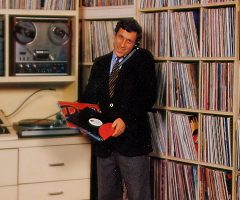
Barry Lederer in Graebar Studio
hotdiscomix: How many records do you have in your collection at home?
Barry Lederer: About 40,000 12" Singles and LPs and about 5,000 CDs.
hotdiscomix: With such a large record collection, you surely have some rare items. What particular recordings are your treasures?
Barry Lederer: “Woman” by Barrabas, “Tell Me What You Want” by Jimmy Ruffin, “Rain 2000” by Titanic, “Rain” by Dorothy Morrison, “Life and Death In G & A” by Abaco Dream, “Black Skin Blue Eyed Boys” by The Equals, “Working On A Building Of Love” by Chairmen Of The Board, and so many others that filled one side of a record like Voyage, Pinocchio, and “Love To Love You Baby” by Donna Summer. There are just too many.
hotdiscomix: In your opinion, which producers and record labels were very important for the disco era?
Barry Lederer: There are so many, so let me just a name a few. Certainly, Cerrone, Jacques Morali, Holland–Dozier–Holland, Giorgio Moroder, Tom Moulton, all those of the philly sound.
And the record labels Invictus, Buddah, Prelude, Butterfly, Casablanca were in the forefront.
hotdiscomix: Which was the first 12" single?
Barry Lederer: It was “Ten Percent” by Double Exposure on Salsoul Records — remixed by Walter Gibbons.
hotdiscomix: “Ten Percent” was the first commercial 12" single, but which was the first promotional 12" single?
Barry Lederer: The first promotional 10" single was the Bob Crewe production “Get Dancin’” by Disco Tex & His Sex-O-Lettes on Chelsea Records and the first 12" promo was “Swearin’ To God” by Frankie Valli on Private Stock.
Fashion Shows:
hotdiscomix: Beginning in early 80s until today, you made tapes for fashion shows. How did this new career start and for what fashion designers, magazines and major stores have you worked?
Barry Lederer: It started as a lucky fluke. When I was out at Fire Island, I had the fortune to meet many New York designers. You must know that the Pines at that point was hot and all the leading designers, or anyone in the arts, went out there. Therefore, to have been a part of that music scene was very important. Also during my years there, the Island was known for throwing some of the best parties in the world. I was lucky enough to do the music and sound for many of them, which led me to fashion. After the summer was over I was asked to do music for the fashion designer Bill Blass. Not being a fashion music expert, I did a somewhat poor job. However I was given a second chance and did much better. This designer recommended me to a major store and I did fashion shows that they had in the store. Long story short, one thing lead to another and before long I was doing a majority of the fashion shows in New York. I have also worked in London, Paris and Milan. At one point, most likely mid to late eighties, I hit a peak. I was really doing well. Eventually, others came along and the work got farmed out. Nonetheless, I still work as of today and am well known in the industry. These last few years the work has been primarily in the US, since every one has had budget cuts.
I have worked for just about every designer at one time or another during my career, including Calvin Klein, Donna Karan, Vivienne Tam, Ralph Lauren, Nicole Miller, Oscar De La Renta, Tommy Hilfiger, Avirex, and Ekho. These are some biggies, but I have worked for many who were just starting and then became famous, like Badgley Mischka. As you can see, it goes from the very high end of couture to real street hip-hop designers.
I have worked for almost every major store in the US, such as Sak’s, Neiman Marcus, Macy’s, Bloomingdales, Bergdorf Goodman, Nordstrom, and on and on, as well as for fashion magazines: among these, 17, Glamour, Elle, Vanity Fair and just about any other that is devoted to fashion.
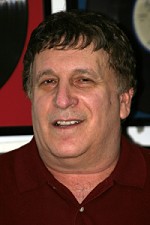
Barry Lederer 2003
hotdiscomix: What is your most memorable fashion show experience?
Barry Lederer: The day I pushed the wrong button and the music stopped. Also, working with MTV on their “Fashionably Loud” series.
hotdiscomix: Finally, are there any other thoughts or news that you would like to share?
Barry Lederer: I guess I would first like to say thank you for your interest and time to interview me. I would hope that DJs of today go back to the roots and see where the wonderful music came from, and use it for inspiration and to do their own thing.
hotdiscomix: Thanks Barry, it has been a pleasure chatting with you and discussing your work. I wish you continued success in your career and future endeavors.